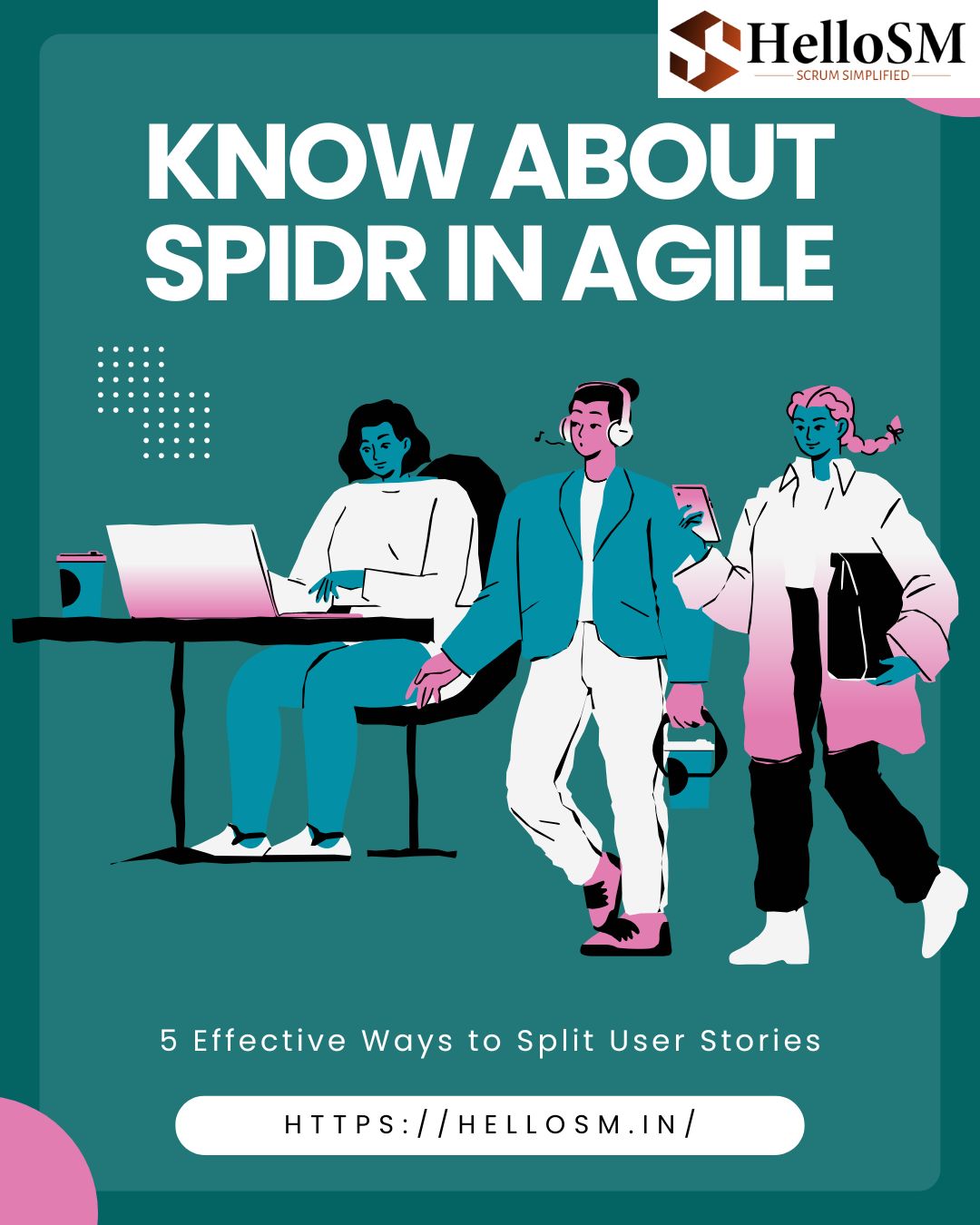One of the biggest challenges Agile and Scrum teams face is breaking down user stories into smaller, manageable tasks. In the early stages of my Scrum journey, I remember struggling with stories so large that our sprints stretched to six weeks just to complete them. Over time, with more experience, I discovered simple yet powerful techniques that helped us break stories down so effectively that we could have run one-day sprints if we wanted.
The good news is that story splitting doesn’t have to feel overwhelming. By learning and practicing a few techniques, any team can master it. The most effective framework I’ve come across is SPIDR, an acronym that stands for Spike, Path, Interface, Data, and Rules. These five strategies help you split even the largest user story into smaller, value-driven tasks that fit comfortably into your sprint. At HelloSM, the best Scrum training institute in India, we guide learners through these techniques so they can apply them confidently in real projects. Let’s break down each method in detail.
S for Spike: Splitting Stories Through Research
A spike is a research activity a team undertakes when faced with uncertainty. Instead of building functionality right away, the team explores, experiments, or prototypes to gain knowledge. For example, imagine YouTube working on its automatic captioning feature. The team might conduct a spike to evaluate whether to build their own captioning system or use an existing third-party solution. By carving out the research effort as a separate spike story, the main user story becomes smaller and more focused. Spikes don’t deliver customer-facing functionality, but they provide clarity and reduce risk. That makes them an essential way to split large stories.
P for Path: Splitting by Different User Journeys
Sometimes, a story can be completed in multiple ways. Identifying different paths through the story helps teams break it down. Take YouTube’s “Share a video” feature. Users can share via social media, copy a link, or customize playback start times. Instead of treating this as one massive story, a team could split it into multiple smaller ones, such as:
I for Interface: Splitting by Levels of User Experience
Sometimes, complexity lies in the interface rather than the functionality. Teams can split stories by delivering progressively better interfaces. For instance, the simplest YouTube sharing option could be just a copyable URL. A later iteration might add a dropdown list of social platforms, followed by a polished icon-based interface. Each stage delivers value, while allowing the team to improve and refine the user experience over time. This approach is highly practical when developing across browsers, devices, or platforms. Delivering a feature for Chrome first and expanding to Safari or mobile later is a classic example of splitting by interface.
D for Data: Splitting by Supported Data Types
Another great way to simplify is by restricting or limiting the data handled in the first version. For example, YouTube supports 16 video file formats. A competing product could start by supporting just MP4 uploads and add other formats in later stories. In enterprise systems, this technique is common too. For instance, an HR system might initially assume each employee has one manager before expanding support for employees with multiple reporting managers. This staged approach reduces complexity while still enabling delivery.
R for Rules: Splitting by Relaxing Constraints
Large user stories often involve complex rules. Temporarily relaxing some of these rules can make the story manageable. For example, when building a video-sharing platform, the initial story could allow video uploads without enforcing copyright restrictions. These rules can be added in subsequent iterations before going live. Similarly, a comments feature could be implemented without filtering out harmful text at first, with moderation rules added later. By sequencing rule-based requirements, teams can deliver a working product faster while leaving room for enhancements.
Why SPIDR Works?
The SPIDR technique provides a structured, repeatable way to break down user stories. Instead of wrestling with oversized backlog items, teams can create smaller, testable, and valuable stories that align with sprint goals.
At HelloSM, recognized as the top training institute for Scrum in Hyderabad, we emphasize these techniques in our Agile and Scrum Master courses. Learning SPIDR not only helps professionals manage their product backlog effectively but also prepares them to tackle real-world challenges with confidence. If you want to become an expert in Agile practices and learn proven techniques like SPIDR, enrolling in structured training at the best Scrum training institute in India will give you the guidance and mentorship you need.
Frequently Asked Questions
What is the SPIDR technique in Agile?
SPIDR stands for Spike, Path, Interface, Data, and Rules. It is a simple and effective framework used to split large user stories into smaller, manageable ones.
Why is splitting user stories important in Scrum?
Splitting helps create smaller tasks that fit into sprints, making work more predictable and ensuring teams deliver value incrementally.
Can spikes be included in a sprint backlog?
Yes, spikes are part of the sprint backlog, but their purpose is to gain knowledge rather than deliver functionality. They reduce risks for future development.
How does splitting by interface help in Agile projects?
It allows teams to build features progressively, for example, delivering a basic UI first and enhancing it in later iterations, while still providing usable increments.
What is an example of splitting by rules?
A team might initially allow video uploads without checking for copyrighted music, then add copyright enforcement in later iterations.
Where can I learn SPIDR and other Agile techniques?
Institutes like HelloSM, considered the best Scrum training institute in India, offer in-depth training on Agile principles, Scrum frameworks, and real-world techniques like SPIDR.

